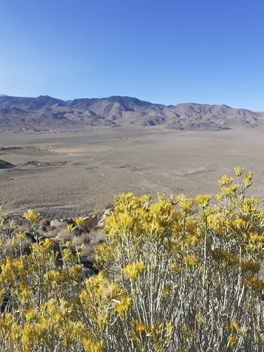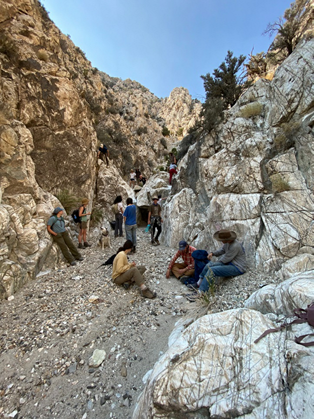From English Fells to Californian Desert
November 9, 2020
Back in Autumn, our Young Ambassador Rosemary Kelly swapped Cumbria for Deep Springs College in California to live, study and labour on a small cattle ranch / university that teaches Hobbesian philosophy and horsemanship.
Her new home is a two-hour drive from Death Valley and certainly removed from the sweeping fells of England.
Moving so far away could be frightening for some people so here she writes about how to explore an entirely alien environment.
First things first, always investigate the potential hazards before venturing out into your new surroundings. I didn’t! As a result, I came up pretty close and personal with a Tarantula Hawk, a large flying insect with one of the most painful stings, before realising it was a risk.
Here, in Deep Springs Valley, we have rattlesnakes, black-widow spiders living under the sinks, mice that carry Hantavirus, air thick with wildfire smoke and the ever-present sun. With a degree of awareness and a lot of sunblock, these hazards shouldn’t be a problem.
So, you’ve asked about and discovered the potential risks … and filled a gallon (about four litres) bottle of water, what’s next? Take a path and head out into the wilderness. L.L. Nunn, founder of Deep Springs College, said that: “the desert has a deep personality; it has a voice”. Listen to this voice. Allow your feet to wander. Forget yourself.

I miss the rain. It hasn’t rained since I got here in August. I miss feeling mud squelch between my toes and seeing the slumbering Howgill Fells and the colour of dying bracken and sheep meandering across the road. I miss red squirrels, drystone walls and falling autumnal leaves. I miss stairs (this is earthquake territory so no stairs allowed) and calling cilantro coriander and thick Cumbrian accents that you can barely understand.
When you wake up with the stars at 6.00am in the morning to move an irrigation line you forget your longings, you just breathe. A coyote, or maybe if you’re lucky a bob-cat or a crane, is stood in the corner of the field. It spent last night howling at the moon. The sun rises over the Sierra mountains and for a moment the sky is a maze of silky pink spider’s webs. Take a plunge in the lower reservoir – the biting cold wraps around your chest and your nerves tingle. A few coots float on the water. Here we swim naked so you stand for a while wholly human, looking out on the fields of alfalfa grass, lapping up the desert sun.
Life feels so different here. Instead of bog cotton and sphagnum moss, I am surrounded by Mormon’s tea and sage bush. It’s exciting to try something new, to taste my alien surroundings. I went for a hike the other day with my class to Marble Canyon – a gorge in the mountains with pillars of shining marble and the occasional green spring. Water takes on a different beauty when it is such a rarity.

But you don’t have to travel across an ocean to discover somewhere new. You don’t even need to be in a “wild” area. Try walking down your street.
Listen to the sparrows, the cars, your feet on the pavement. Watch for dandelions in the verge, the falling crimson leaves, the clouds in the sky. Smell the honeysuckle climbing your neighbours’ fence, the fresh cut grass in a nearby park and rain on dry concrete.
If we are the successfully protect our planet from climate change, we need to start by listening to its voice. The desert isn’t the only place with a “deep personality”. All environments, be it urban or rural, have their own voice.
Just sometimes you need to listen a little harder.







